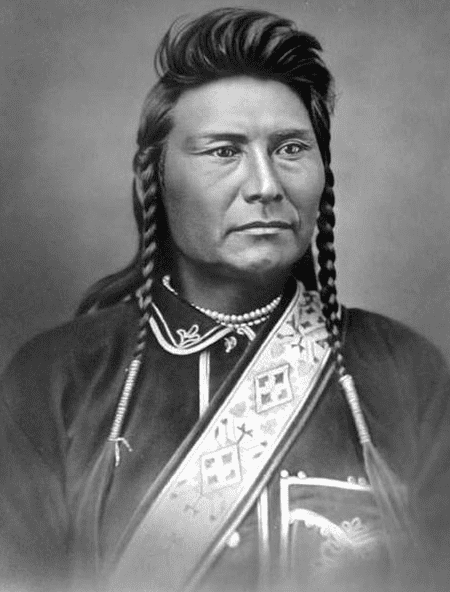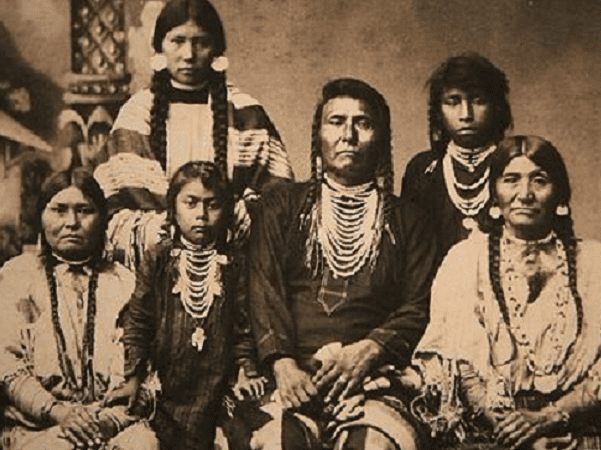For three desperate months in 1877, Chief Joseph led his band of 700 Nez Perce Indians on an arduous flight toward freedom in Canada, trying to escape the relentless pursuit of 2,000 U.S. soldiers. The 200 warriors in the band kept fighting brilliant rearguard actions, repeatedly holding off the soldiers while their women, children and elders struggled through the difficult mountain terrain.

This deadly chase went on for more than 1,000 miles, through Oregon, Washington, Idaho, Wyoming and Montana. Finally, on 5 October 1877, tired of the constant fighting and with his people freezing and out of food, Chief Joseph realized his band could stand no more. With great dignity the saddened chief surrendered to General Nelson Miles.
They were less than 40 miles from the Canadian border and safety.

Chief Joseph’s actual words of surrender were written down after the fact and may have been embellished, but his sorrowful conclusion is embedded in American history:
“It is cold, and we have no blankets; the little children are freezing to death. My people, some of them, have run away to the hills, and have no blankets, no food. No one knows where they are – perhaps freezing to death. I want to have time to look for my children, and see how many of them I can find. Maybe I shall find them among the dead. Hear me, my chiefs. I am tired; my heart is sick and sad. From where the sun now stands, I will fight no more forever.”
The following three newspaper articles describe the Nez Perce retreat and Chief Joseph’s surrender. The first is a straightforward report of the surrender. The second, from an Oregon newspaper, says the Nez Perce “do fight stoutly,” and concludes by referring to the ordeal of their retreat and capture as a “tragedy.” The third article, printed by the newspaper run by the Mormon Church in Utah, begins to lay the foundation for the modern estimation of Chief Joseph as a great leader and peaceful humanitarian.
Here is a transcription of this article:
THE NEZ PERCES
Gen. Terry’s Account of the Surrender of Joseph’s Band
CHICAGO, Oct. 9. – The following dispatch is just received at headquarters:
DISTRICT OF THE YELLOWSTONE,
CAMP ON EAGLE CREEK, MONTANA,
Oct. 5, 1877.
Gen. A. H. Terry, Commanding Department of Dakota:
DEAR GENERAL – We have had our usual success. We made a very direct and rapid march across the country, and after a severe engagement, and being kept under fire for three days, the hostile camp of the Nez Perces, under Chief Joseph, surrendered at 2 o’clock today. I intend to start the 2d Cavalry toward Benton on the 7th instant. Can not supplies be sent out on the Benton road to meet them and return with the remainder of the command to the Yellowstone?
I hear that there is trouble between the Sioux and the Canadian authorities.
I remain, General, yours very truly,
NELSON A. MILES,
Col. Brevet Maj. Gen., U.S.A., commanding.
As soon as the companies of the 2d Cavalry of which Gen. Miles speaks arrive here, the commission will start for Fort Walsh.
[Signed] ALFRED H. TERRY,
Brigadier General.
Here is a transcription of this article:
ANOTHER HARD BLOW
Those Nez Perces still fight as outlaws might be expected to fight who see the gallows before them. When this machine of an ignominious death is seen at the end of every vista, even an Indian may be expected to fight; and the Nez Perces do fight stoutly. Miles’ battle seems to be quite as severe as Gibbon’s was. Undoubtedly when the band left Idaho the purpose was to go to Wind river. Until they reached the national park, on the upper Yellowstone, this purpose was not changed. Learning there how hopeless it would be to attempt to elude pursuit in that direction, they started from the national park due north for the British line. Crossing the Yellowstone near the junction of Clarke’s fork with that stream, they continued their flight with a rapidity that left all pursuers far in the rear; they crossed the Missouri river not far below Fort Benton, and were within forty miles of the British line when struck by Gen. Miles.
Snake creek is a stream flowing into Milk river. Its course is northeasterly. Miles’ battleground is perhaps eighty or hundred miles northeast of Fort Benton. One of the numerous ridges of the Rocky mountains through which the Missouri river must force its way before it reaches the open plains of its middle course is called on the north side of the river Bear’s Paw mountain; on the south, Highwood mountain. By taking any ordinary map the reader will be able, with the aid furnished by this description, to find the locality of the battle. It will be easy also to trace the route which the hostile band must have pursued from the national park and Yellowstone lakes to Miles’ battleground.
The soldiers evidently behaved well. The Indians appear to have been driven off the field, and to have been forced to leave their dead and wounded behind them. It cannot be doubted that their present condition is very miserable. Worn with hard travel and smitten first by one force and then by another, they must be greatly reduced in numbers by this time; and if Miles has been able to hold them till Howard and Sturgis could come up, the end may already have been reached. Having lost their horses and been driven into deep ravines, where they were blockaded when the courier left, it seems not improbable that the remnant has been or may be captured.
– A later dispatch tells the balance of the story. The remnants of the hostile Nez Perces have been forced to surrender. Gen. Howard’s dispatch announces the close of the tragedy, and the title to Wallowa valley and other disputed localities is quieted at last.
Here is a transcription of this article:
The Surrender.
The Indian war just concluded by the surrender of Chief Joseph to General Miles is probably unparalleled. Throughout the campaign the Indians have shown magnanimity, generosity and even bravery that have been worthy the emulation of their white antagonists. Such a man as Joseph is not a savage by instinct or otherwise. His entire conduct throughout this war, if it can be so entitled, has shown plainly that he was not fighting to satiate a desire to wantonly and savagely shed the blood of his fellow creatures. His frequent action in liberating women and children, and the fact that his enemies say, in speaking of the fighting Nez Perces, “they are credited with numerous acts of humanity to wounded whites,” show plainly that he has not been prompted by a spirit of revenge. The object must then have been of a higher order, and one probably that would, combined with the intrepidity, bravery, ability and magnanimity he has displayed, have stamped him as one of the heroes of the times, but for the fact that he is an Indian.
Notwithstanding the higher civilization claimed by the Whites, in the war just ended there has been a transposition of the evidences of true civilization from the White to the Indian.
The best method of solving Indian difficulties is to take the position and maintain it that the Red Men have rights that demand as much respect as those of their white neighbors. They should be taught and generously aided in the cultivation of the arts of peace and industry. In these matters the Latter-day Saints are setting an example that is worthy of emulation by all.
Note: An online collection of newspapers, such as GenealogyBank’s Historical Newspaper Archives, is not only a great way to learn about the lives of your ancestors – the old newspaper articles also help you understand American history and the times your ancestors lived in, and the news they talked about and read in their local papers. Do you have Native American ancestry in your family line? Please share your stories with us in the comments section.
Related Articles:
